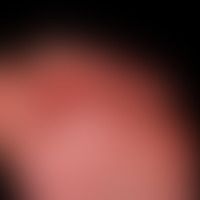
Acrodermatitis continua suppurativa L40.2
Acrodermatitis continua suppurativa: for years a chronic recurrent clinical picture with painful pustules, nail destruction with formation of erosive areas

Chilblain lupus L93.2
Chilblain lupus: extensive, painful redness of the plantar side of several toes.

Foot infection gram-negative L08.8
Gram-negative foot infection: Dorsal side in case of gramnegative foot infection.

Melanoma acrolentiginous C43.7 / C43.7
melanoma, malignant, acrolentiginous. reddish, partly skin-coloured, slowly growing, coarse plaque, which has predominantly displaced the nail bed. there are also bizarre, black-brown hyperpigmentations. the nail plate is no longer existent except for a rest.

Melanoma amelanotic C43.L
Melanoma, malignant, acrolentiginous. solitary, chronically stationary, slowly increasing, localized at the right big toe, measuring approx. 0.5 cm, touch-sensitive, red node ulcerated with a dark pigmented part (see circle and arrow marking) Histology: tumor thickness 2.7 mm, Clark level IV, pT3b N0 M0, stage IIB.

Foot infection gram-negative L08.8

Melanoma cutaneous C43.-
Amelanotic acrolentiginous malignant melanoma: slowly growing nodule known for several years; increasing nail destruction in the last six months, also weeping and bleeding, sometimes slight pain; encircled and marked with an arrow, deep-seated pigment remains, which suggest the diagnosis "malignant melanoma".

Melanoma amelanotic C43.L
Melanoma malignes amelanotic: since early childhood a pigment mark is known at this site. Only in the last months this site has bled with slight traumas. There are no other complaints.

Acrodermatitis continua suppurativa L40.2
Acrodermatitis continua suppurativa: Pronounced, local therapy-resistant, pustular, acral dermatitis with extensive destruction of the big toe nail.

Gout M10.0
Arthritis urica: suddenly (overnight) very painful (walking only possible with difficulty) redness and swelling of both metatarsophalangeal joints of the big toe, both 3rd toes as well as collateral of the left back of the foot (here no significant pressure pain). Known hyperuricemia

Dyshidrotic dermatitis L30.8
Dyshidrotic dermatitis: chronic recurrent dermatitis on several toes. recurrent episodes with itchy blisters. no signs of atopy. no contact allergy.

Chronic mucocutaneous candidiasis B37.2
Candidosis, chronic mucocutaneous (CMC): Inflammatory redness and yellowish keratotic plaques of the interdigital spaces in a 3-year-old boy with simultaneous, therapy-resistant candidosis of the oral mucosa.

Dyshidrotic dermatitis L30.8
dyshidrotic dermatitis: chronic recurrent hyperkeratotic dermatitis of the hands and feet. detailed view of the toes. recurrent episodes with itchy blisters. no signs of atopy. no contact allergy

Melanoma acrolentiginous C43.7 / C43.7
Melanoma, malignant, acrolentiginous. 2 x 3 cm diameter, red, flat, slightly putrid ulceration on the right big toe of a 73-year-old woman. At the lateral border of the ulcer there are shadowy pigment remains (circled and marked with arrows) in intact skin. In addition, palpation of the peripheral venous leg stations on the right inguinal side shows several enlarged venous leg ulcers (DD: reactive enlargement?).

Primary cutaneous diffuse large cell b-cell lymphoma leg type C83.3
Primary cutaneous diffuse large-cell B-cell lymphoma leg type: a 3-month-old , constantly growing, non-painful, blurred, moderately consistency increased (consistency of soft eraser), red surface smooth lump in an otherwise healthy woman.

Foot infection gram-negative L08.8
In the area of the forefoot and the digites I and II, a foul-smelling, yellowish-smeary ulceration extending to the subcutis is visible. Furthermore, there are chronically stationary, long-standing, skin-coloured papules (papillomatosis cutis lymphostatica) aggregated to form bed formations, as well as partially whitish macerated toe spaces.

Foot infection gram-negative L08.8
foot infection, gram negative with intergital fly maggot infestation

Gout M10.0
Arthritis urica: sudden spontaneously occurring spontaneously and under slight pressure painful (walking is difficult) redness and swelling of the right metatarsophalangeal joint of the big toe Known hyperuricemia






